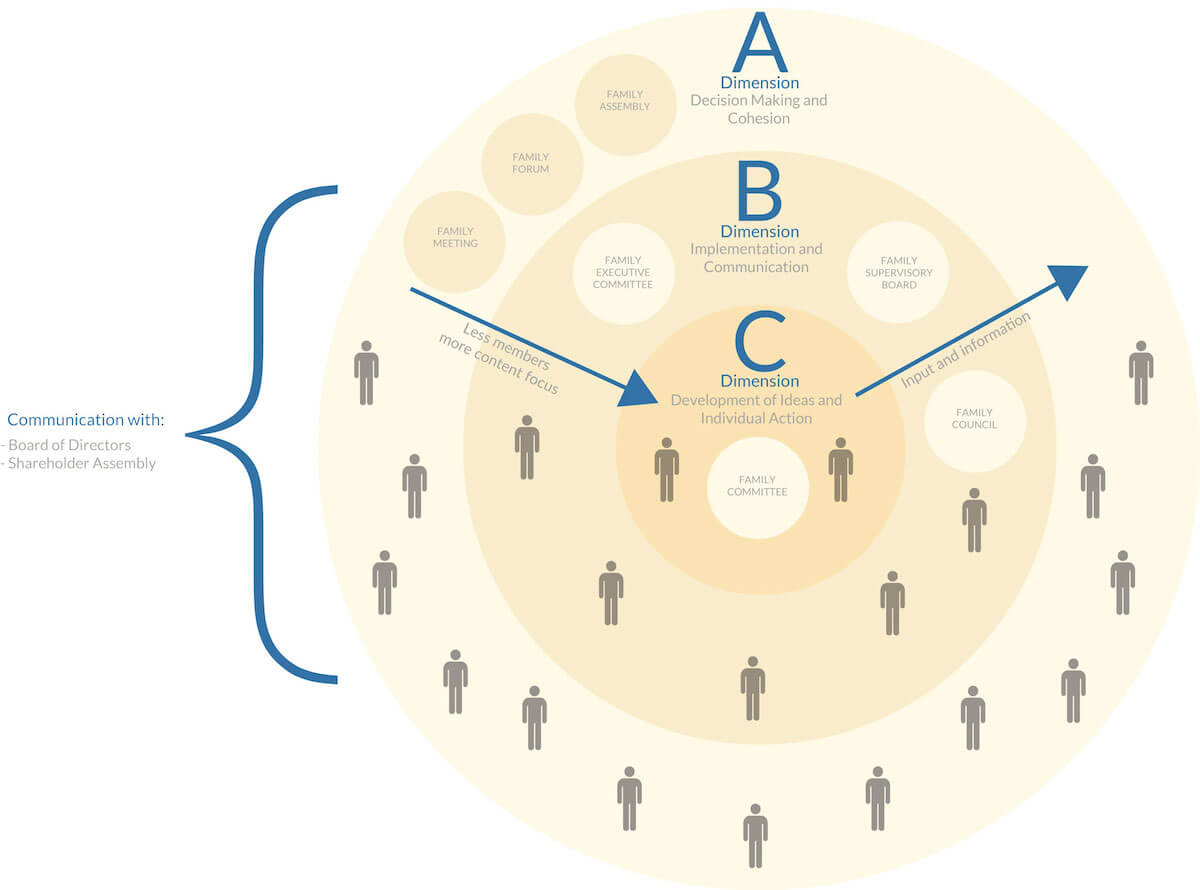By Farida F. El Agamy, Attorney-at-Law, General Manager of Tharawat Family Business Forum
Anyone who is part of a family business knows how addressing important issues, or collectively taking decisions can sometimes be a difficult process. Whether it is because family members do not want to “open the can of worms” and risk long debates, or whether the opposing opinions are so clear that nobody believes that a solution can be found, the common denominator is that often business families do not have systems in place to open a positive dialogue. Understanding that this can damage the family cohesion and negatively impact the business, over the past decades, family businesses all over the world have worked on implementing structures allowing them to effectively manage their companies, take decisions as owners and govern their family relationships. The use of “Family Institutions” as a way to address these questions has greatly increased over the past years and appears to enjoy great success in many families.
The first rule when it comes to Family Institutions is that there are no rules. This characteristic greatly differentiates them from the dominant rules and best practice we find in corporate governance or the legal requirements of the ownership system – family institutions are hardly ever regulated, unified or codified. This means that each family can (and has to) decide for themselves, what set up and system works best for them. The structure will of course greatly be influenced by factors such as the:
- age of the family business
- number of family members
- number of businesses that the family runs and owns
- number of generations involved
As an example, a family with 10 family members from two generations, running a steel factory might just have one Family Institution, such as a Family Council. Whereas, a family with 80 family members, three generations, and a diversified portfolio of businesses might have various institutions, including committees, and family gatherings.
Family Institutions in the Governance System
Taking a step back, we can see that family Institutions are not just a communication tool for family members but can be an important part of the complex governance system that applies to a family business. The overall family business governance system comprises the sub-systems of corporate governance, ownership governance and family governance. Each of those sub-systems has its own rules and regulations and of course organs or institutions that are tasked with the continuous implementation and improvement of the systems.

Management of the Company
Governance rules: Corporate Governance, Codes and Handbooks
Top Institution: Board of Directors
Organisation of the Ownership
Governance rules: Shareholder Agreements
Top Institution: Shareholders Assembly
Organisation of the Family
Governance rules: Family Constitution
Top Institution: differs
Family Institutions – The Three Dimensions
There is somewhat of a “war” raging when it comes to defining family institutions. Terminology can differ according to country, to size of the family, and to the advisor working with the family. We have tried to break down the three key levels on which Family Institutions operate and to show the engagement and roles of the family members.
Dimension A: Decision Making & Cohesion
Possible Names:
- Family Assembly
- Family Forum
- Family Meeting
Membership:
Meeting with all family members, both active and non-active in the business. These meetings can include in-laws or be restricted to blood relatives. Some families agree to have attendance and voting restriction on certain topics, or limit participation to family members of a certain age.
Possible functions:
- Define the family vision and the family’s philanthropic values
- Broadly discuss family issues and business performance
- Social function for family networking
- Information of the next generation
- Election of family council and family committee members
- Decision of important family policies (employment policy, compensation schemes, etc.)
Meeting Frequency:
Normally, Family Assemblies or Family Forums take place once a year and in large families they can coincide with Shareholder meetings.
Dimension B: Implementation & Communication
Possible Names:
- Family Council
- Family Executive committee
- Family Supervisory Board
Membership:
The Family Council can be composed of family members elected or appointed by the Family Assembly, or of a certain branch or generation.
Possible functions:
- In-depth discussion of issues facing the family business
- Implementation of the rules and regulations in the family constitution
- Link to the company and the business Board of Directors
- Conflict resolution
- Supervising philanthropic activities
- Programs for the next generation
- Communication with family
Meeting Frequency:
Often, Family Council type institutions meet quarterly or even more often. They can coincide with Board of Directors meetings to leverage on communication.
[ms-protect-content id=”4069,4129″]
Dimension C: Development of Ideas & Individual Action
Possible Names:
- Family Committee
Membership:
Depending on the governance structure, family members can be nominated by the Family Assembly or the Family Council to join a Family Committee.
Possible functions:
- Short-term mandate.
- Focus on a specific area such as next generation development, benefit policies, family branding, organising a family retreat etc.
- It normally reports to one of the upper Family Institutions.
Meeting Frequency:
Family Committees vary a lot in their organisation and structure. Since Family Committees and similar institutions are often limited in time and have a clear mandate to fulfil, they may meet more frequently than the other Family Institutions.
Over the past years, “Family Offices” have become very popular instruments amongst family business owners. Initially mainly used for the management of private family wealth and investments, today Family Offices often take on various other tasks and activities. Family Offices can take over functions in succession planning, family support functions, and even in organising and supporting meetings and events for the other Family Institutions. Since often the Family Office staff are non-family members, this can both be a great advantage, as well as a challenge. It is an advantage in that the organisation of Family Institutions can be more efficient when it is part of a staff member’s job description. On the other hand, it could allow employees insights into very personal aspects of the family and its business, which depending on the situation may not always be appropriate.
How to do it – Balancing Influence and Staying Relevant
Often the process of setting up Family Institutions is part of the development process of a family constitution and overall family business governance system. Unfortunately, sometimes signing the constitution is the main focus of the process and less attention is given to building realistic institutions that should thrive in the future, implement the family’s vision and meet the set expectations.
Families in the process of developing their Family Institution or Institutions should carefully consider a couple of key points:
- Don’t follow templates – analyse your family, its structure, the number of people and their possible level of engagement first.
- Think about what you really need to improve decision-making and implementation, and not about what looks good from the outside.
- Be realistic in your expectations of the family institutions – do not overpower the family with too many meetings and different institutions.
- Consult with experts, as well as your family members on the structure and functions of your family institution(s).
- Constantly monitor the efficiency and effectiveness of your Family Institutions.
- Do not lose sight of the reason why the Family Institutions were set up.
- Communicate! Communication is at the core of a well functioning Family Institution and family governance system.
Ultimately, a well-functioning system of Family Institutions requires one more key success factor: Balance. First of all, it is important that the influence of individual family members or of groups of family members is fairly spread across the system. This can help develop real dialogue over time and reduce the risk of overpowering politics or standoff situations. Secondly, family members, who are not actively involved in the business, or who do not have a professional career need to be supported in communicating their thoughts. As family members they are an important part of the supporting system of the business and, especially if they are current or future owners, the family institutions are a great place to involve them actively. Thirdly, the various governance bodies must reach a balance with each other. The Board of Directors, Shareholders Assembly and Family Institutions should ideally work in harmony, respect each other’s roles and follow a common purpose.
Building successful Family Institutions is not easy. It takes a lot of hard work, dedication and often uncomfortable discussions. However, the outcome of having a strong system to rely on, that can carry the family through difficult times and be a platform for family members to express themselves is well worth the effort.
Tharawat Magazine, Issue 28, 2015
[/ms-protect-content]













